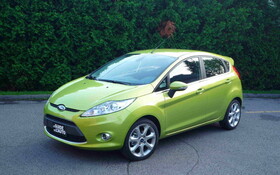2010 Ford Fiesta: A taste of things to come
There’s a fire in Ford’s belly. Under Alan Mullaly’s direction, the giant from Dearborn is offering a whole bunch of new models. And, in what is perhaps a sign of the times, they’re showing renewed interest in sub-compact vehicles, a segment that’s increasingly showing promise. Traditionally, American manufacturers have not been inclined to push this category, simply because the models were too expensive to make given their sale price.
If you think back far enough though, you’ll recall that Ford already tested these waters with the Euopean-made Fiesta, which was sold on our continent in the early 80s. This small car demonstrated better-than-average road handling and offered a fairly pleasant ride. But that didn’t seem to be enough, and Ford had to let it go. A few years later, Ford tried its luck with another model, the Festiva, which was made in Korea by Kia. While the first generation may have done alright, the second was a total flop, prompting Ford to drop the category once again.
This time around, however, Ford is doing everything it can to ensure its corner of the market. And as testament to its good intentions, Ford brought a few European models to North America so that future clients and the press could give them a try. And that’s exactly what we did!
Sleek silhouette
I’ve got to say that Ford has penetrated this segment smack dab in its middle. This vehicle sports dynamic lines that get noticed. As we took it for a test over several days on Quebec highways, we received plenty of compliments on it. We tested a five-door hatchback that will be imported over. There will also be a sedan, which the Dearborn stylists will design.
For a sub-compact vehicle, the 2010 Ford Fiesta offers a remarkable interior with decent comfort up front. The seats may be a little on the soft side, but at least they’ve got enough bolstering on the sides for good lateral support. The quality of the materials is good and the dashboard is quite stylish. The indicators are tucked into a unit in the dashboard, while the brushed-steel central console is the true pièce de résistance, floating just above a screen with orange numbers displayed on a black background. The console features a multitude of buttons for the computer system, the audio system and other things of that nature. Another unit – this one vertical and located just below the dash – contains the air con system, which is simple to use and highly effective. Also worth noting are USB and MP3 docks on the central console between the to front seats.
The rear seat is fairly comfortable provided that the front seats haven’t been moved back all the way and that you’re flexible enough to get in. Finally the trunk space is easy to access thanks to a good-sized rear hatch and the cargo hold is fairly generous. If you need additional cargo space, you can fold down the 60/40 back seat. That said, on he model we tested the back of the rear seat was made out of a slippery metal that was really easy to scratch. But, of course, that was the European model. Surely it will be modified for our market.
Double the savings
A low starting price and low fuel consumption are two factors that attract a lot of buyers to sub-compacts. To attain these objectives, the engineers had to find an engine that was good on gas and a platform that was relatively inexpensive to develop and manufacture. This version, which was launched in 2008, is derived from the Mazda 2, Ford’s partner for small cars. The platform is truly rigid, with a strut front suspension and a rear twist beam suspension. I’ll also point out that there are disk brakes in front and drum brakes in back.
The vehicle we tested had a 1.6-litre 120-hp four-cylinder engine coupled with a five-speed manual transmission. Currently, European buyers can opt for a four-speed automatic, if they prefer. However, if the North American version came with a dual-clutch transmission, that would give the Ford Fiesta a unique offering in its category.
Comfortable and pleasant
With 120 horses under the hood, don’t expect explosive accelerations. And frankly, that’s not the point in this category anyway. This engine is relatively quiet and free of vibrations. The gears on the five-speed manual transmission are well spaced, but the shifter is a little loose. We were able to attain 0-100km/hr in under 10 seconds, which is not bad when you consider that other vehicles in this category take at least another full second to do the same.
The road handling is what you’d expect, though the body leans on curves due to the flexible suspension. The steering could also offer a little more feedback, but it’s precise nonetheless and has a good amount of assistance, which is not a bad thing when you consider that this is primarily a city car. Out on the open road, the Fiesta does reasonably well, with good soundproofing and resistance to side winds. And with those comfy front seats, you could easily cover long distances in this vehicle without getting too tired. Ford has also thought to help drivers by placing the cruise control buttons on one of the steering wheel spokes.
In short, this first introduction to the Ford Fiesta left a positive first impression, as much for the design, interior comfort and performance on the road. Now the ball is in Ford’s court. They’ve got to come up with a North American version with the better qualities of the European version and some adjustments for our market.












